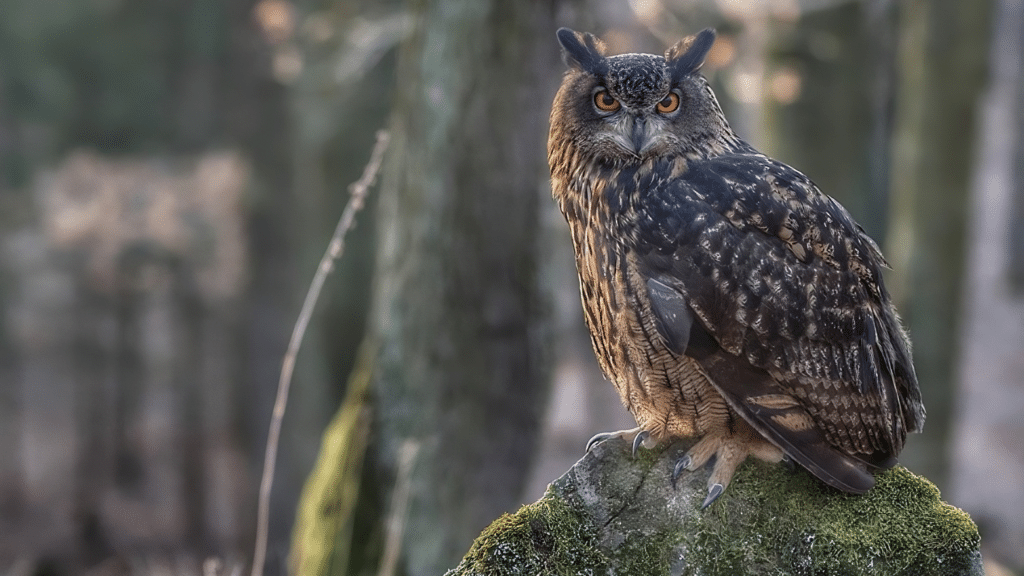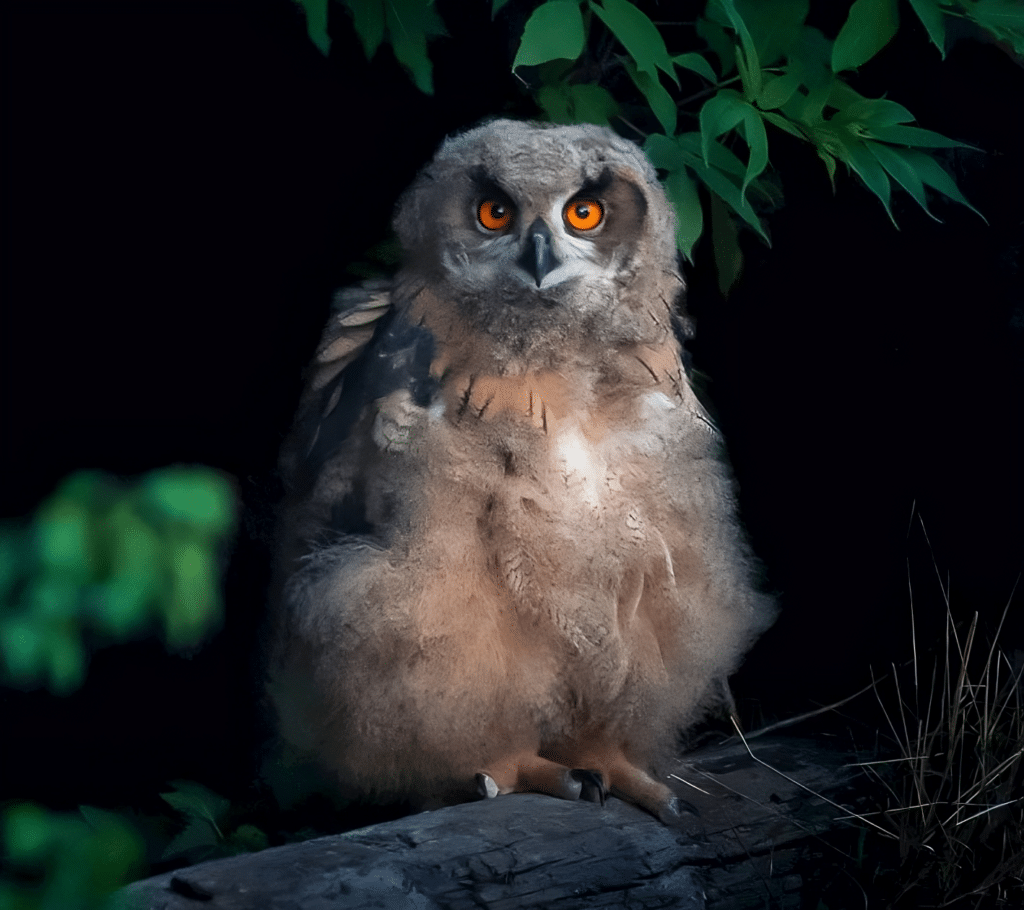The European eagle owl (Bubo bubo), also known as the Eurasian eagle-owl, is a large bird of prey found in various habitats across Europe, Asia, and parts of North Africa. This species is known for its impressive physical characteristics, including its size and distinctive facial features. The European eagle owl has a diverse diet and feeding habits, primarily consisting of small mammals but also including birds and occasionally reptiles. In terms of breeding and reproduction, this species exhibits specific behaviours and communication patterns. However, the conservation status of the European eagle owl is currently a concern due to various threats it faces in its natural environment.
Habitat and Distribution
The European eagle owl (Bubo bubo) is typically found in a wide range of habitats across Europe, Asia, and North Africa. This species exhibits diverse migration patterns that vary depending on geographical location and environmental conditions. In some regions, such as northern Europe, the European eagle owls are sedentary and do not undertake long-distance migrations. However, in other areas like Central Asia, these owls may migrate seasonally in search of suitable prey and breeding territories.
Physical Characteristics
Characterised by a large size, the European eagle owl possesses prominent tufts of feathers on its head. It is known for its distinctive physical characteristics which aid in its predator-prey dynamics and hunting techniques. With a wingspan reaching up to six feet, this species has the ability to silently glide through the night sky, allowing it to surprise its prey. The owl’s sharp talons and beak enable it to capture and kill a wide range of prey items including mammals, birds, and reptiles. Its exceptional vision allows it to spot small animals from great distances even in low light conditions. Additionally, the owl’s ability to rotate its head almost 270 degrees enhances its agility while hunting.

Diet and Feeding Habits
With a diverse diet consisting of mammals, birds, and reptiles, the European eagle owl demonstrates an adaptable feeding behaviour. This large owl species employs various predation techniques and hunting strategies to capture its prey. The primary hunting technique used by the European eagle owl is called sit-and-wait predation. Perched on a high vantage point, such as a tree branch or rock ledge, it remains motionless for extended periods of time, patiently observing its surroundings. Once potential prey is detected through keen eyesight and acute hearing, the owl swoops down silently with powerful wings to catch its target. Its strong talons are capable of exerting substantial force, enabling it to grasp and immobilise prey effectively.
In addition to sit-and-wait predation, the European eagle owl also engages in active hunting when necessary. It can fly swiftly and silently over open areas or through dense vegetation to locate and pursue prey actively. This combination of predatory techniques allows the European eagle owl to successfully secure food from a wide range of sources in different habitats throughout its distribution range.
Breeding and Reproduction
Breeding and reproduction in Bubo bubo involve a complex set of behaviours and physiological processes. The breeding season for European Eagle Owls typically occurs during late winter to early spring, with variations depending on geographical location. Courtship behaviour plays a crucial role in the breeding process, serving as a means for pair formation and mate selection. Male owls engage in elaborate displays such as hooting, wing-clapping, and aerial acrobatics to attract females. Once a pair has formed, they establish their territory and construct nests on cliffs or in trees. Female owls lay an average of 2-3 eggs, which are incubated by both parents for about 35 days. After hatching, the chicks are cared for by both parents until they fledge at around 50-60 days old. Successful breeding requires synchronisation of these behaviours with environmental cues and availability of suitable habitat and prey resources.

Behaviour and Communication
The behaviour and communication of European eagle owls (Bubo bubo) can be examined through their vocalisation and gestures, as well as their social interaction patterns. Vocalisation plays a crucial role in communication for these birds, with various calls used for different purposes such as territorial defence or attracting mates. Additionally, gestures such as head movements and wing displays are also employed to convey messages. Furthermore, the social interaction patterns of European eagle owls involve territoriality and pair bonding, which contribute to their overall behaviour and communication strategies.
Vocalisation and Gestures
Vocalisation and gestures of the European eagle owl are important forms of communication within their social interactions. Vocalisations play a crucial role in conveying information and maintaining social cohesion among individuals. These vocal signals can be interpreted by other owls, enabling them to recognise individuals, establish territories, and coordinate activities such as hunting or defending against predators. The interpretation of vocalisations is largely based on contextual cues and variations in pitch, duration, and intensity.
In addition to vocalisation, non-verbal communication through gestures also plays a significant role in owl social interactions. Gestures such as head bobbing, wing spreading, or feather ruffling can convey aggression, submission, or territoriality. By combining vocalisations and gestures in their communication repertoire, European eagle owls effectively convey messages within their social group without relying solely on verbal language.
Social Interaction Patterns
Social interaction patterns among the European eagle owl are influenced by a variety of factors, including environmental conditions and social hierarchy. Territorial behaviour is an important aspect of their social interactions, as they defend their territory from intruders through aggressive displays and vocalisations.
Mating rituals also play a significant role in shaping their social interactions. Male owls engage in courtship behaviours such as presenting food offerings to females and engaging in elaborate aerial displays. These rituals serve to establish and strengthen pair bonds between males and females.
Additionally, social hierarchies within owl communities can influence the frequency and nature of interactions between individuals. Dominant owls often have priority access to food resources and mates, while subordinate owls may be excluded or engage in submissive behaviours towards dominant individuals.
This discussion will focus on the conservation status and threats faced by the European eagle owl (Bubo bubo). Three key points to be addressed are habitat destruction causes, illegal wildlife trade risks, and conservation efforts and success. Habitat destruction poses a significant threat to the European eagle owl population, as it diminishes their available nesting sites and food sources. Illegal wildlife trade also poses a risk, as these owls are often sought after for their feathers or kept as exotic pets. However, various conservation efforts have been implemented to mitigate these threats and ensure the long-term survival of this majestic species.
Conclusion
The European eagle owl (Bubo bubo) is a large bird of prey found across Europe, Asia, and parts of North Africa. It inhabits diverse habitats such as forests, mountains, and rocky areas. With a wingspan of up to six feet and distinctive ear tufts, it is one of the largest owl species in the world.
The diet of the European eagle owl mainly consists of small mammals but can also include birds and reptiles. Breeding takes place during early spring, with females laying two to four eggs in nests built on cliffs or trees. The species exhibits territorial behaviour and uses various vocalisations for communication. Despite being listed as least concern by the IUCN, habitat loss and persecution pose threats to its population.
In conclusion, the European eagle owl is an impressive bird that has adapted well to different environments but faces conservation challenges due to human activities.
Additional Resources
Sources and References
- Taylor, M. (2014). The Owl: An Owl Book for the Owl-Minded. Bloomsbury Natural History.
- Toms, M. P. (2014). Owls. Bloomsbury Publishing.
Sam loves to learn about animals and their habitats. He has been a nature lover from a very young age, and has been writing papers and articles about wildlife for as long as he can remember.
